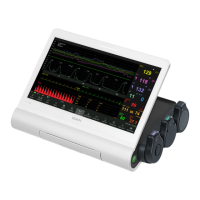F15 Series Fetal & Maternal Monitor User Manual After Monitoring
- 100 -
3 Do not perform SpO
2
measuring and NIBP measuring on the same arm at one time,
because obstruction of blood flow during NIBP measuring may adversely affect the
reading of SpO
2
numeric.
4 Prolonged and continuous monitoring may increase jeopardy of unexpected change of
dermal condition such as abnormal sensitivity, rubescence, vesicle, repressive
putrescence, and so on. It is especially important to check the sensor placement of
neonate and patient of poor perfusion or immature dermogram by light collimation and
proper attaching strictly according to changes of the skin.
5 The maximum application time of the SpO
2
sensor at a single site is 3 hours. Check per 2 ~
3 hours the sensor placement and move it when the skin deteriorates. More frequent
examinations may be required for different patients.
6 Setting the SpO
2
higher alarm limit to 100% is equivalent to switching off the alarm on
higher limit. High oxygen levels may predispose a premature infant to retrolental
fibroplasia. Therefore, the higher alarm limit for oxygen saturation must be carefully
selected in accordance with commonly accepted clinical practices.
7 If a sensor is too loose, it might compromise the optical alignment or fall off. If it is too
tight, for example because the application site is too large or becomes too large due to
edema, excessive pressure may be applied. This can result in venous congestion distal
from the application site, leading to interstitial edema, hypoxemia, and tissue malnutrition.
8 Do not apply sensor too tightly as this results in venous pulsation which may severely
obstruct circulation and lead to inaccurate measurements.
9 At elevated ambient temperatures, be careful with measurement sites that are not well
perfused, because this can cause severe burns after prolonged application. All listed
sensors operate without risk of exceeding 41°C on the skin if the initial skin temperature
does not exceed 35°C.
CAUTION
Compatibility between the monitor and transducer should be verified before use to avoid
injuring the patient or operator.
NOTE:
1 The device is calibrated to display functional oxygen saturation.
2 A functional tester cannot be used to assess the accuracy of the SpO
2
transducer or the
monitor.
3 The monitor does not have specific SpO
2
calibration baselines.
4 SpO
2
waveform is not proportional to the pulse volume.
5 Injected dyes such as methylene blue or intravascular dyshemoglobins such as
methemoglobin and carboxyhemoglobin may lead to inaccurate measurements.
6 SpO
2
measurement is not applicable during low perfusion and movement.
Measurement Limits -
In operation, the accuracy of oximetry readings can be affected by:
1) Magnetic resonance imaging (MRI) scanning. Induced current could potentially cause burns.
2) Excessive patient movement.
3) Low perfusion.
4) High-frequency electrical noise, including noise created by the host system, or noise from
external sources, such as electrosurgical apparatus, which is admitted by the host system.
5) Intravascular dye injections.
6) Improper sensor application.
Traditional 510(k) of Fetal & Maternal Monitor
014_14.1_F15_Series_User_Manual

